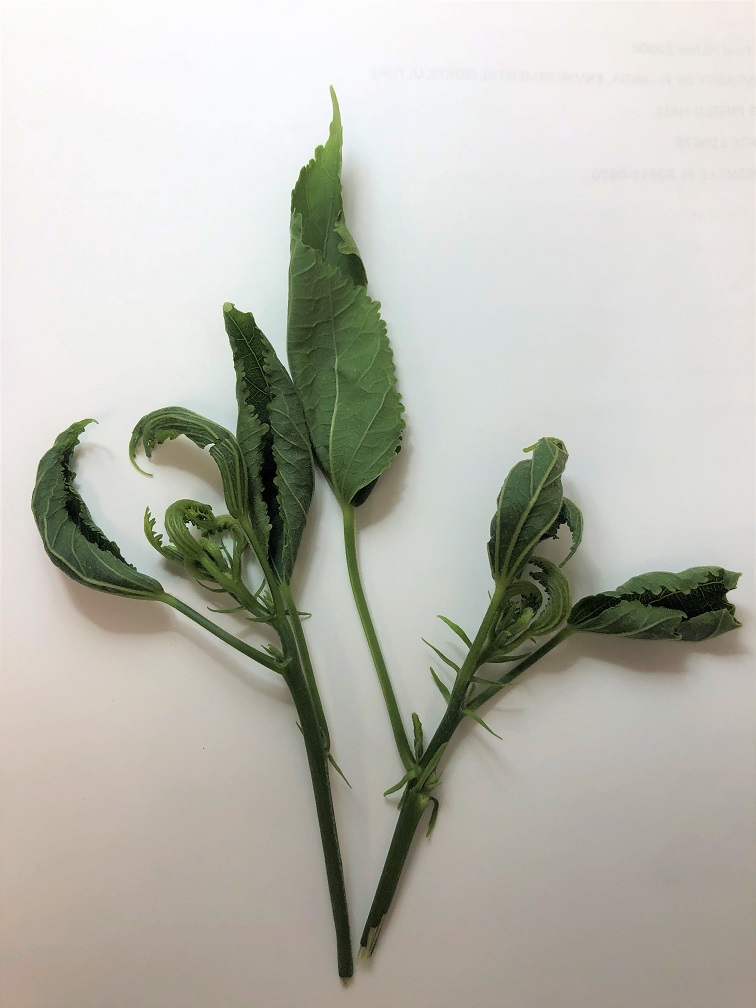As an Extension Agent or a Master Gardener Volunteer, we oftentimes find ourselves serving as plant doctors, or even as investigators trying to solve mysteries on the farm or landscape. One type of case we see quite frequently is the mysterious case of curling, disfigured leaves on ornamental plants, trees and crops as pictured here.

Recently, we had a homeowner present to us photos of her Turk’s cap bush that was showing strange curling and cupping of the leaves at the top of the plant and new growth. A red flag that indicated this was likely not pest or disease was that these same symptoms had appeared on multiple other types of plants in her yard at about the same time, including a couple of small trees, roses and succulents. Usually, pests and diseases will only affect a couple of plants in the landscape and typically the same type of plant. Pest and disease issues also happen over a longer period of time, typically a couple of weeks to months getting worse as it progresses. This distortion of the leaves though happened quite quickly and over multiple different types of plants.
As we talked we dug a bit deeper, asking our usual investigative questions regarding watering, growing conditions, and if she has seen any bugs or other critters. Then the question was asked, “Has any herbicide been applied around these plants?” An herbicide is a product used to kill plants, usually weeds. There are many different types of herbicides that work in different ways to get the job done. Unfortunately, when not used according to the label or when the environmental conditions at the time of spraying aren’t right, accidental damage and even death can occur to desirable plants. She responded that yes, someone had sprayed in the last couple of weeks to kill weeds in her grass and it was after then that the curling leaves started to appear. She came in the following day with samples of the affected plants and the bottle of herbicide used and the case was solved.
On each of the affected plants was the characteristic curling and cupping of the leaves indicating herbicide damage which, in this case proved to be 2, 4-D. 2, 4-D is a very common herbicide available to homeowners to control turfgrass weeds. Oftentimes it’s combined with other active ingredients such as dicamba and mecoprop to create 3-way herbicides that are readily used. Unfortunately, as mentioned above, when these herbicides are not used carefully and according to the label instructions, damage or death to landscape beds and trees can easily occur. The label of the product used in this case stated that it should not be applied when temperatures are above 90 degrees and never should an herbicide be used before heavy rain or during windy conditions. These last few weeks have been unusually hot and breezy and so we can venture to guess that with these conditions the herbicide drifted onto the trees and shrubs where it did the accidental damage, a very easy mistake to make. Studies have shown that a tiny 5 micron-sized droplet (like a fog-sized droplet) of herbicide can travel 3 miles in a 3 mph breeze, and even a large 1000 micron droplet (about the size of a moderate rain drop) can travel 4.7 feet in a 3 mph breeze!
Thankfully, for this homeowner the majority of the plants accidentally hit by the herbicide drift will likely recover just fine with time. But it serves as a great reminder to anyone applying pesticides or herbicides to always, always, always read and follow the label instructions. If you’re trying to spray weeds that are close to desirable plants, place a barrier like the plastic lid from a tote box or a smashed down cardboard box between the weed you’re spraying and the plant you want to protect. And watch the weather. Some herbicides, 2,4-D included, can easily travel through the soil and be absorbed through the roots of trees, flowers and shrubs if it rains or is irrigated before the herbicide has completely dried. This can also be a hazard to human and environmental health if these chemicals are sprayed near a well or body of water like a retention pond or stream. So use caution, wear the recommended protective equipment such as glasses, gloves and long sleeves, and always follow the label instructions. Your UF/IFAS Marion County Extension Service is also here to answer your questions and to serve as your plant detectives!
Florida Homeowner Herbicide Guide: Considerations, Applications, and Selection
 1
1
